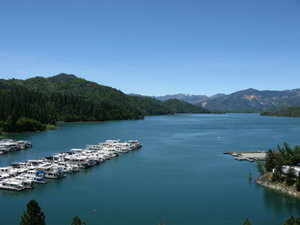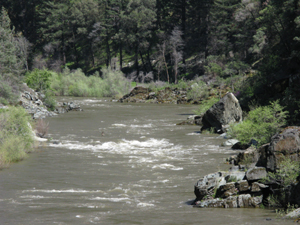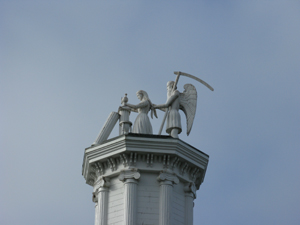Californians keep a careful eye on water. We talk about droughts and floods, and we learn about tide tables.
In the winter, Northern Californians like to monitor the snow pack in the mountains and predict the effects on
 Lake Hennessey reservoir
reservoir levels. During our years in California, we have most frequently visited reservoirs which are half-full
or less, but this year the reservoirs have been catching up. When the state's largest man-made reservoir, Shasta Lake, south of majestic Mount Shasta,
became more than ninety per cent full, we decided to drive up and see it.
Lake Hennessey reservoir
reservoir levels. During our years in California, we have most frequently visited reservoirs which are half-full
or less, but this year the reservoirs have been catching up. When the state's largest man-made reservoir, Shasta Lake, south of majestic Mount Shasta,
became more than ninety per cent full, we decided to drive up and see it.
We began with a drive through the hills west of Interstate 5 (we avoid freeways whenever possible) to Chico, where
we stayed overnight and breakfasted with grandson Dan. The road we chose winds through wineries and olive groves and
many cattle ranches in the foothills. We stopped at a couple of small reservoirs and enjoyed seeing them
full enough to touch the reeds and grasses along the shore. West of Chico we spotted an eagle's nest on a power pole.
 Eagle nest
With patience and binoculars we could pick out the head of the mother eagle on her nest.
Eagle nest
With patience and binoculars we could pick out the head of the mother eagle on her nest.
North of Chico we drove through Corning, a major olive processing center, and then stopped briefly at the Coleman National Fish Hatchery, where salmon fingerlings are raised and transferred to several
Northern California rivers. This was the quiet time for the hatchery; the salmon transfers take place in the late Fall and
Winter.
Lake Shasta was beautiful, its waters lapping against the green shore, with the snowcapped mountain in the distance. It was
 Lake Shasta houseboat marina
also peaceful with only a handful of boaters to enjoy the spring sunshine. The reservoir looks complex on the map, with
fingers of land stretching out from the many little islands. Looking at the houseboats in the marina, we imagined that
exploring the lake at leisure must be enjoyable even in high summer.
Lake Shasta houseboat marina
also peaceful with only a handful of boaters to enjoy the spring sunshine. The reservoir looks complex on the map, with
fingers of land stretching out from the many little islands. Looking at the houseboats in the marina, we imagined that
exploring the lake at leisure must be enjoyable even in high summer.
Our reservoir curiosity nicely satisfied, we headed west. The Trinity river accompanied us for many miles. It was flooding
over its banks and providing beautiful white water areas here and there. We climbed into the Trinity Alps on a road which
 Rushing Trinity River
twisted and turned and occasionally spat out gravel. We would have taken more photos, but the narrow road offered few chances
to linger -- and we had started this leg of our trip later in the day than we had intended.
Rushing Trinity River
twisted and turned and occasionally spat out gravel. We would have taken more photos, but the narrow road offered few chances
to linger -- and we had started this leg of our trip later in the day than we had intended.
Over the Trinity Alps we went, and ended our second day in Arcata, in a brand new, somewhat expensive but oh, so comfortable Hampton
Inn. After the excellent motel breakfast, we headed for the Victorian town of Ferndale. After appreciating the lovely old buildings, we
took one turn and were instantly relocated to Mattole Road, a cliff-hugging twisty and much-patched trail which reached, then followed the coast until it  Isolated farm on Lost Coast
found the Mattole River. Reputedly the name "Lost Coast" is due to the inability of highway engineers to construct a State Highway that could penetrate this challenging topography. It's very beautiful.
Isolated farm on Lost Coast
found the Mattole River. Reputedly the name "Lost Coast" is due to the inability of highway engineers to construct a State Highway that could penetrate this challenging topography. It's very beautiful.
After a couple hours of this we found ourselves in Honeydew where we planned to cut back through the Humboldt Redwoods State Park to Highway 101.
But there, scribbled on a small piece of paper was a sign informing us that the road was closed because of a marathon race being held that day. So, ever reluctant to retrace our steps, we headed further south along Wilder Ridge Road, reasonably named. We eschewed the dirt Kings Peak Road, which was marked on the map with the thinnest of black lines, and continued to Ettersburg, where we picked up the Briceland Thorn Road which put us in Garberville in time for a late lunch!
 Carson Mansion, Fort Bragg
Carson Mansion, Fort Bragg
Just south of some more redwood parks, California Highway 1, called Shoreline Highway, turned off, and we followed along for what is probably the finest oceanside ride in the State -- slightly better, in our opinion, than the road from Big Sur to San Simeon. In Fort Bragg we were the only guests in one building of a hilltop motel which had a "partial ocean view" and also a tub. We woke up on a crisp, sunny morning with just a touch of breeze. Before breakfast we drove
 Like Queen Anne's Lace
through the town, enjoying the Victorian buildings and the restored Old Town. The Carson Mansion is the featured sight.
Like Queen Anne's Lace
through the town, enjoying the Victorian buildings and the restored Old Town. The Carson Mansion is the featured sight.
Our after-breakfast walk took us to the headlands
in Jughandle State Park, where a pair of geese led us along the trail to the cliffs.
All along this part of the coast, we saw wildflowers, the most impressive being one we called (apparently incorrectly) Queen Anne's
Lace. It looks like the big sister of the wildlower we knew from Ohio. It grows several feet tall, and seems to be getting
 Time and the Maiden
bigger before our eyes! If anybody knows the name of this flower, we'd love to hear it.
Time and the Maiden
bigger before our eyes! If anybody knows the name of this flower, we'd love to hear it.
Occasionally we caught a glimpse of a
cattle ranch or a farm, but most of this land was wonderfully empty. The beaches are beautifully rocky with black sand.
The town of Mendocino is quaint and pretty. We marveled at the statue of Time and the Maiden atop the local bank.
The original building, built in 1866, was the Masonic Lodge. The builder, Erik Albertson, a Mason, carved the statue from a single
log.
We crossed into Sonoma County and found ourselves in still beautiful, though more familiar, territory. We agreed that this
was a grand trip, with perfect weather and excellent tour guides (us).
 Lake Hennessey reservoir
reservoir levels. During our years in California, we have most frequently visited reservoirs which are half-full
or less, but this year the reservoirs have been catching up. When the state's largest man-made reservoir, Shasta Lake, south of majestic Mount Shasta,
became more than ninety per cent full, we decided to drive up and see it.
Lake Hennessey reservoir
reservoir levels. During our years in California, we have most frequently visited reservoirs which are half-full
or less, but this year the reservoirs have been catching up. When the state's largest man-made reservoir, Shasta Lake, south of majestic Mount Shasta,
became more than ninety per cent full, we decided to drive up and see it.
 Eagle nest
Eagle nest Lake Shasta houseboat marina
Lake Shasta houseboat marina Rushing Trinity River
Rushing Trinity River Isolated farm on Lost Coast
Isolated farm on Lost Coast Carson Mansion, Fort Bragg
Carson Mansion, Fort Bragg Like Queen Anne's Lace
Like Queen Anne's Lace Time and the Maiden
Time and the Maiden